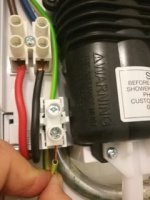Man of Honour
Hi All,
I am hoping we have some resident electricians here who can guide me,
My estate agent commissioned the replacement of the electric shower in my rented accommodation, however the new shower trips the MCB if used for more than 6-7 minutes.
I have done my own prodding and found out that the shower installed is 9.5kw (Triton Enrich) but is installed behind a 32A MCB (Wylex NSB32) on what "appears" to be 6mm2 core cable. Our incoming voltage is around 230v on the dot.
Looking at the datasheet for the NSB32, a trip time of around 10 minutes at 130% load (41A, I calculated) seems to be about right.
The agency are refusing to accept that the installation is incorrect, so I was wondering if anyone could point me at the part of the electrical code that covers this ?
Thanks!
I am hoping we have some resident electricians here who can guide me,
My estate agent commissioned the replacement of the electric shower in my rented accommodation, however the new shower trips the MCB if used for more than 6-7 minutes.
I have done my own prodding and found out that the shower installed is 9.5kw (Triton Enrich) but is installed behind a 32A MCB (Wylex NSB32) on what "appears" to be 6mm2 core cable. Our incoming voltage is around 230v on the dot.
Looking at the datasheet for the NSB32, a trip time of around 10 minutes at 130% load (41A, I calculated) seems to be about right.
The agency are refusing to accept that the installation is incorrect, so I was wondering if anyone could point me at the part of the electrical code that covers this ?
Thanks!




